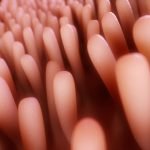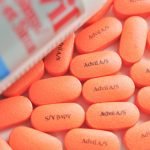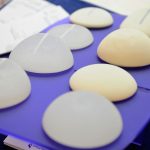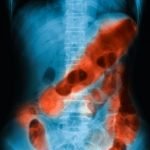Elucidating Estrogen Receptor Sites
Ronald Steriti, ND, PhD
Estrogen effects are mediated through 2 different estrogen receptors (ERs), ERα and ERβ.1,2 Both receptors are widely expressed in various tissue types. However, there are some notable differences in their expression patterns.3-5 Estrogen receptor α is found in endometrium, breast cancer cells, ovarian stroma cells, and the hypothalamus. In males, ERα protein is found in the epithelium of the efferent ducts. Expression of ERβ protein has been documented in kidney, brain, bone, heart, lungs, intestinal mucosa, prostate, and endothelial cells.
Breast Cancer
Estrogen receptors are overexpressed in approximately 70% of breast cancer cases, which is referred to as ER positive. While ERα promotes breast cell proliferation, ERβ inhibits proliferation and prevents breast cancer development via G2 cell cycle arrest.1,6,7 Loss of ERβ expression is a common step in estrogen-dependent tumor progression.8
Prostate Cancer
In the prostate, ERβ is highly expressed in the epithelial compartment, where it is the prevailing isoform. A recent study9 showed that increased expression of ERα is a negative prognostic predictor in human prostate cancer. Another study10 found that ERβ-activated apoptosis in benign hyperplasia and cancer of the prostate is androgen independent and is mediated by tumor necrosis factor.
Colon Cancer
In healthy colon mucosa, ERβ is the prevalent receptor subtype expressed, while ERβ expression is considerably reduced in colon tumors.11,12 It is possible that compounds that promote expression and activation of ERβ signaling in the colon may help to reduce the incidence of colon cancer.13
Ovarian Cancer
Loss of ERβ expression or a decrease in the ratio of ERβ to ERα in epithelial ovarian cancer cells compared with healthy tissue has been reported.14 A 2007 study15 showed that overexpression of ERβ in ovarian cancer cells exerts antitumor effects.
ERβ Agonists
It has been proposed that ERβ-selective agonists might be a safer alternative for long-term hormone therapy.16 This is based on observations that ERα promotes proliferation of breast cancer cells, whereas ERβ acts as a tumor suppressor, and that both forms are effective in transcriptional repression of inflammatory genes responsible for osteoporosis.
Estrogens
Various ligands differ in their affinity for α and β isoforms of the ER.17,18 While 17β-estradiol binds equally well to both receptors, estrone selectively activates ERα at a ratio of 5:1, and estriol binds to ERβ at a ratio of 3:1.
Estriol
In contrast to the selective ERα binding by other estrogens, the unique ability of estriol to bind to ERβ imparts to estriol a potential for breast cancer prevention. Other estrogens would be expected to promote breast cancer.
Acting alone, estriol is a weak estrogen, but it functions as an antiestrogen when administered with estradiol. Estriol competitively inhibits estradiol binding and inhibits activated receptor binding to estrogen response elements, which limits transcription.19
A recent study20 showed that estriol acts as a G protein–coupled receptor 30 (GPR30) antagonist in ER-negative breast cancer cells. Estriol was able to inhibit GPR30-mediated responses such as rapid activation of extracellular signal–regulated kinase, upregulation of target genes such as c-fos and connective tissue growth factor, and proliferative effects observed in ER-negative breast cancer cells.
Dehydroepiandrosterone
Dehydroepiandrosterone (DHEA) binds to ERα and ERβ, with Ki values of 1.1 and 0.5 µM, respectively. Despite the similar binding affinities, DHEA showed preferential agonism of ERβ, with a half-maximal effective concentration of approximately 200 nm and maximal activation at 1 µM. With ERα, 30% to 70% agonism was found at 5 µM, depending on the assay.21
Androstanediol and Prostate Cancer
In the prostate, ERβ is highly expressed in the epithelial compartment, where it is the prevailing isoform. 5α-Androstane-3β,17β-diol (3β-Adiol) inhibits the migration of prostate cancer cell lines via ERβ activation.22 In addition, 3β-Adiol activates ERβ.23,24 Furthermore, 3β-Adiol binds to ERβ but not to androgen receptors.25
Androstanediol and Breast Cancer
As already noted, ERα promotes breast cell proliferation, while ERβ inhibits proliferation and prevents breast cancer development via G2 cell cycle arrest.1 A recent study26 found that 3β-Adiol induces breast cancer growth via ERα. The authors state that 3β-Adiol is a weak agonist of ERα growth induction but do not mention its effect on ERβ.
A 1960 article published in Cancer, however, showed that 3β,17β-androsanediol (diacetate) was as effective as testosterone propionate in breast cancer suppression.27 Although this may be a synthetic compound (drug) that is similar but not identical to 3β-Adiol, the results are very promising.
Phytoestrogens
Phytoestrogens are plant-derived diphenolic or polyphenolic compounds that are structurally similar to estrogens and thus induce estrogenic responses in mammals. It was reported more than 10 years ago that phytoestrogens can bind and activate ERs.28 Of particular interest is that many phytoestrogens bind with a higher affinity for ERβ compared with ERα.13
Genistein
Genistein, a well-known phytoestrogen abundantly present in soy products, had an extremely high binding affinity for ERβ (almost identical to that of the endogenous hormone estradiol).17 However, its binding affinity for ERα was only 6% of its binding affinity for ERβ.
Licorice
Liquiritigenin, an active component of licorice, is the most active estrogenic compound from the root of Glycyrrhizae uralensis Fisch. A 2008 study29 showed that liquiritigenin activated multiple ER regulatory elements and native target genes with ERβ but not ERα.
Trifolium pratense and Cimicifuga
A recent study30 showed that Trifolium pratense supplementation increased expression of ERα in the endometrium without increasing cell proliferation. In the same study, Cimicifuga showed the lowest expression of ERα compared with a placebo group. This suggests an inhibitory effect of Cimicifuga extract on endometrial proliferation similar to selective ER modulator activity. The authors proposed that combined use of T pratense and Cimicifuga racemosa extracts could be a therapeutic approach to menopausal symptoms. This may provide endometrial protection via synergism between these herbal extracts, with benefits in different tissues (vascular endothelium, bone, skin, and lungs) mediated by Trifolium isoflavones, while hypothalamic activity of Cimicifugacould reduce vasomotor symptoms.
Equol
Equol (4′,7-isoflavandiol) is an isoflavandiol metabolized from daidzein, a type of isoflavone, by bacterial flora in the intestines. Only about 30% to 50% of individuals have intestinal bacteria that produce equol.31,32
While endogenous estrogenic hormones such as estradiol are steroids, equol is a nonsteroidal estrogen. It may have beneficial effects on the incidence of prostate cancer and on physiological changes after menopause.33-36
Equol specifically binds 5α-dihydrotestosterone but not testosterone, DHEA, or estrogen with high affinity.37 S-equol preferentially activates ERβ.38,39
Twenty-eight Japanese healthy volunteers (18 equol producers and 10 equol nonproducers) aged 30 to 59 years were given soy isoflavone (60 mg daily) supplements for 3 months.40 After 3-month supplementation, the serum levels of sex hormone–binding globulin had significantly increased, while the serum levels of free testosterone and dihydrotestosterone had significantly decreased. The authors suggested that equol nonproducers could become producers by prolonged soy isoflavone intake.
 Dr. Ron Steriti, ND, PhD, is researcher for Dr Jonathan V. Wright of the Tahoma Clinic and Meridian Valley Labs in Renton, Washington. He is a graduate of Southwest College of Naturopathic Medicine and has a PhD in electrical engineering from the University of Massachusetts at Lowell.
Dr. Ron Steriti, ND, PhD, is researcher for Dr Jonathan V. Wright of the Tahoma Clinic and Meridian Valley Labs in Renton, Washington. He is a graduate of Southwest College of Naturopathic Medicine and has a PhD in electrical engineering from the University of Massachusetts at Lowell.
References
1. Paruthiyil S, Parmar H, Kerekatte V, Cunha GR, Firestone GL, Leitman DC. Estrogen receptor β inhibits human breast cancer cell proliferation and tumor formation by causing a G2 cell cycle arrest. Cancer Res. 2004;64(1):423-428.
2. Paech K, Webb P, Kuiper GG, et al. Differential ligand activation of estrogen receptors ERα and ERβ at AP1 sites. Science. 1997;277(5331):1508-1510.
3. Couse JF, Lindzey J, Grandien K, Gustafsson JA, Korach KS. Tissue distribution and quantitative analysis of estrogen receptor-α (ERα) and estrogen receptor-β (ERβ) messenger ribonucleic acid in the wild-type and ER α-knockout mouse. Endocrinology. 1997;138(11):4613-4621.
4. Hess RA. Estrogen in the adult male reproductive tract: a review. Reprod Biol Endocrinol. 2003;1:e52.
5. Babiker FA, De Windt LJ, van Eickels M, Grohe C, Meyer R, Doevendans PA. Estrogenic hormone action in the heart: regulatory network and function. Cardiovasc Res. 2002;53(3):709-719.
6. Haeger P, Andrés ME, Forray MI, Daza C, Araneda S, Gysling K. Estrogen receptors α and β differentially regulate the transcriptional activity of the urocortin gene. J Neurosci. 2006;26(18):4908-4916.
7. Pettersson K, Delaunay F, Gustafsson JA. Estrogen receptor β acts as a dominant regulator of estrogen signaling. Oncogene. 2000;19(43):4970-4978.
8. Bardin A, Boulle N, Lazennec G, Vignon F, Pujol P. Loss of ERβ expression as a common step in estrogen-dependent tumor progression. Endocr Relat Cancer. 2004;11(3):537-551.
9. Fujimura T, Takahashi S, Urano T, et al. Increased expression of estrogen-related receptor α (ERRα) is a negative prognostic predictor in human prostate cancer. Int J Cancer. 2007;120(11):2325-2330.
10. McPherson SJ, Hussain S, Balanathan P, et al. Estrogen receptor–β activated apoptosis in benign hyperplasia and cancer of the prostate is androgen independent and TNFα mediated. Proc Natl Acad Sci U S A. 2010;107(7):3123-3128.
11. Di Leo A, Barone M, Maiorano E, et al. ER-β expression in large bowel adenomas: implications in colon carcinogenesis. Dig Liver Dis. 2008;40(4):260-266.
12. Konstantinopoulos PA, Kominea A, Vandoros G, et al. Oestrogen receptor β (ERβ) is abundantly expressed in normal colonic mucosa, but declines in colon adenocarcinoma paralleling the tumour’s dedifferentiation. Eur J Cancer. 2003;39(9):1251-1258.
13. Swedenborg E, Power KA, Cai W, Pongratz I, Rüegg J. Regulation of estrogen receptor β activity and implications in health and disease. Cell Mol Life Sci. 2009;66(24):3873-3894.
14. Zhao C, Dahlman-Wright K, Gustafsson JA. Estrogen receptor β: an overview and update. Nucl Recept Signal. 2008;6:e003.
15. Treeck O, Pfeiler G, Mitter D, Lattrich C, Piendl G, Ortmann O. Estrogen receptor β1 exerts antitumoral effects on SK-OV-3 ovarian cancer cells. J Endocrinol. 2007;193(3):421-433.
16. Cvoro A, Paruthiyil S, Jones JO, et al. Selective activation of estrogen receptor-β transcriptional pathways by an herbal extract. Endocrinology. 2007;148(2):538-547.
17. Zhu BT, Han GZ, Shim JY, Wen Y, Jiang XR. Quantitative structure-activity relationship of various endogenous estrogen metabolites for human estrogen receptor α and β subtypes: insights into the structural determinants favoring a differential subtype binding. Endocrinology. 2006;147(9):4132-4150.
18. Rich RL, Hoth LR, Geoghegan KF, et al. Kinetic analysis of estrogen receptor/ligand interactions. Proc Natl Acad Sci U S A. 2002;99(13):8562-8567.
19. Melamed M, Castaño E, Notides AC, Sasson S. Molecular and kinetic basis for the mixed agonist/antagonist activity of estriol. Mol Endocrinol. 1997;11(12):1868-1878.
20. Lappano R, Rosano C, De Marco P, De Francesco EM, Pezzi V, Maggiolini M. Estriol acts as a GPR30 antagonist in estrogen receptor–negative breast cancer cells. Mol Cell Endocrinol. 2010;320(1-2):162-170.
21. Chen F, Knecht K, Birzin E, et al. Direct agonist/antagonist functions of dehydroepiandrosterone. Endocrinology. 2005;146(11):4568-4576.
22. Dondi D, Piccolella M, Biserni A, et al. Estrogen receptor β and the progression of prostate cancer: role of 5α-androstane-3β,17β-diol. Endocr Relat Cancer. 2010;17(3):731-742.
23. Handa RJ, Pak TR, Kudwa AE, Lund TD, Hinds L. An alternate pathway for androgen regulation of brain function: activation of estrogen receptor β by the metabolite of dihydrotestosterone, 5α-androstane-3β,17β-diol. Horm Behav. 2008;53(5):741-752.
24. Handa RJ, Weiser MJ, Zuloaga DG. A role for the androgen metabolite, 5α-androstane-3β,17β-diol, in modulating oestrogen receptor β–mediated regulation of hormonal stress reactivity. J Neuroendocrinol. 2009;21(4):351-358.
25. Oliveira AG, Coelho PH, Guedes FD, Mahecha GA, Hess RA, Oliveira CA. 5α-Androstane-3β,17β-diol (3β-diol), an estrogenic metabolite of 5α-dihydrotestosterone, is a potent modulator of estrogen receptor ERβ expression in the ventral prostrate of adult rats. Steroids. 2007;72(14):914-922.
26. Sikora MJ, Cordero KE, Larios JM, Johnson MD, Lippman ME, Rae JM. The androgen metabolite 5α-androstane-3β,17β-diol (3βAdiol) induces breast cancer growth via estrogen receptor: implications for aromatase inhibitor resistance. Breast Cancer Res Treat. 2009;115(2):289-296.
27. Brennan MJ, Beckett MD, et al. Treatment of advanced mammary cancer with 3β, 17β-androstanediol. Cancer. 1960;6(13)1195-1200.
28. Kuiper GG, Lemmen JG, Carlsson B, et al. Interaction of estrogenic chemicals and phytoestrogens with estrogen receptor β. Endocrinology. 1998;139(10):4252-4263.
29. Mersereau JE, Levy N, Staub RE, et al. Liquiritigenin is a plant-derived highly selective estrogen receptor β agonist. Mol Cell Endocrinol. 2008;283(1-2):49-57.
30. Alves DL, Lima SM, da Silva CR, et al. Effects of Trifolium pratense and Cimicifuga racemosa on the endometrium of Wistar rats. Maturitas. 2008;61(4):364-370.
31. Wang XL, Hur HG, Lee JH, Kim KT, Kim SI. Enantioselective synthesis of S-equol from dihydrodaidzein by a newly isolated anaerobic human intestinal bacterium. Appl Environ Microbiol. 2005;71(1):214-219.
32. Frankenfeld CL, Atkinson C, Thomas WK, et al. High concordance of daidzein-metabolizing phenotypes in individuals measured 1 to 3 years apart. Br J Nutr. 2005;94(6):873-876.
33. Akaza H, Miyanaga N, Takashima N, et al. Comparisons of percent equol producers between prostate cancer patients and controls: case-controlled studies of isoflavones in Japanese, Korean and American residents. Jpn J Clin Oncol. 2004;34(2):86-89.
34. Aso T. Equol improves menopausal symptoms in Japanese women. J Nutr. 2010;140(7):1386S-1389S.
35. Ishiwata N, Melby MK, Mizuno S, Watanabe S. New equol supplement for relieving menopausal symptoms: randomized, placebo-controlled trial of Japanese women. Menopause. 2009;16(1):141-148.
36. Duncan AM, Merz-Demlow BE, Xu X, Phipps WR, Kurzer MS. Premenopausal equol excretors show plasma hormone profiles associated with lowered risk of breast cancer. Cancer Epidemiol Biomarkers Prev. 2000;9(6):581-586.
37. Lund TD, Munson DJ, Haldy ME, Setchell KD, Lephart ED, Handa RJ. Equol is a novel anti-androgen that inhibits prostate growth and hormone feedback. Biol Reprod. 2004;70(4):1188-1195.
38. Setchell KD, Clerici C. Equol: pharmacokinetics and biological actions. J Nutr. 2010;140(7):1363S-1368S.
39. Muthyala RS, Ju YH, Sheng S, et al. Equol, a natural estrogenic metabolite from soy isoflavones: convenient preparation and resolution of R– and S-equols and their differing binding and biological activity through estrogen receptors α and β. Bioorg Med Chem. 2004;12(6):1559-1567.
40. Tanaka M, Fujimoto K, Chihara Y, et al. Isoflavone supplements stimulated the production of serum equol and decreased the serum dihydrotestosterone levels in healthy male volunteers. Prostate Cancer Prostatic Dis. 2009;12(3):247-252.










